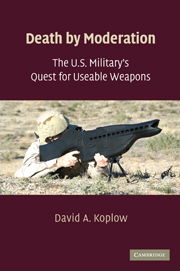Book contents
- Frontmatter
- Contents
- Preface
- Acknowledgments
- Abbreviations and Acronyms
- 1 Revolutionary Weapons and Transformed War
- 2 Deterrence and Self-Deterrence
- 3 The Law of Armed Conflict
- 4 Precision-Guided Munitions
- 5 Low-Yield Nuclear Weapons
- 6 Smart Antipersonnel Land Mines
- 7 Antisatellite Weapons
- 8 Nonlethal Weapons
- 9 What to Do about Useability
- Index
- References
1 - Revolutionary Weapons and Transformed War
Published online by Cambridge University Press: 05 June 2012
- Frontmatter
- Contents
- Preface
- Acknowledgments
- Abbreviations and Acronyms
- 1 Revolutionary Weapons and Transformed War
- 2 Deterrence and Self-Deterrence
- 3 The Law of Armed Conflict
- 4 Precision-Guided Munitions
- 5 Low-Yield Nuclear Weapons
- 6 Smart Antipersonnel Land Mines
- 7 Antisatellite Weapons
- 8 Nonlethal Weapons
- 9 What to Do about Useability
- Index
- References
Summary
Scenario 1
During the second week of May 1972, two strategic bridges in war-torn North Vietnam provided the transportation – both literally and symbolically – into the modern era of aerial conflict.
Both bridges – the Long Bien in the city of Hanoi and the Thanh Hoa, about 150 kilometers south – were high-value targets for American bombers; they served as Ho Chi Minh's principal arteries for road and rail shipments to the south, and clogging those chokepoints would have greatly impeded his effort to reinforce and resupply North Vietnamese and Viet Cong brigades. At the same time, both bridges were frustrating and dangerous to attack; they were so well constructed and well defended that waves of U.S. bombs had failed to penetrate them, and scores of aircraft and crews had been lost in the attempt.
The Thanh Hoa Bridge proved to be an especially alluring target. It was 56 feet wide, 540 feet long, and 50 feet above the water, of steel construction with two spans resting upon a 16-foot reinforced concrete pier in the middle of the Song Me River. The central 12 feet of the bridge fed the main trunk rail line that ran down the Vietnam panhandle; two 22-foot-wide concrete highways that constituted Route 1 were cantilevered on the sides.
But the Thanh Hoa Bridge was also an extraordinarily vexatious target. Construction on the bridge was completed only in 1964; between 1965 and 1968, 800 American sorties had attacked it, unloading some 10,000 tons of high explosives.
- Type
- Chapter
- Information
- Death by ModerationThe U.S. Military's Quest for Useable Weapons, pp. 1 - 27Publisher: Cambridge University PressPrint publication year: 2009



